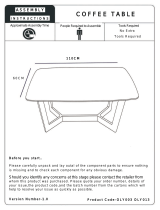
Battery ............................................................................................................................................... 28
SSD ..................................................................................................................................................... 29
Memory modules ............................................................................................................................... 30
WLAN/Bluetooth combo card ............................................................................................................ 32
WWAN module ................................................................................................................................... 34
Keyboard ........................................................................................................................................... 36
6 Removal and replacement procedures for Authorized Service Provider parts ................................................... 39
Component replacement procedures .................................................................................................................. 39
RTC battery ........................................................................................................................................ 40
Internal base plate ............................................................................................................................ 41
Heat sink/fan assembly .................................................................................................................... 43
Power button board .......................................................................................................................... 45
Touchpad button board ..................................................................................................................... 46
USB/audio board ................................................................................................................................ 47
System board .................................................................................................................................... 48
Speaker assembly ............................................................................................................................. 50
Display assembly ............................................................................................................................... 51
Top cover ........................................................................................................................................... 55
7 Computer Setup (BIOS) and MultiBoot ........................................................................................................... 56
Using Computer Setup ......................................................................................................................................... 56
Starting Computer Setup .................................................................................................................. 56
Navigating and selecting in Computer Setup ................................................................................... 56
Restoring factory settings in Computer Setup ................................................................................. 57
Updating the BIOS ............................................................................................................................. 57
Determining the BIOS version ......................................................................................... 57
Downloading a BIOS update ........................................................................................... 58
Using MultiBoot ................................................................................................................................................... 59
About the boot device order ............................................................................................................. 59
Choosing MultiBoot preferences ....................................................................................................... 59
Setting a new boot order in Computer Setup ................................................................. 59
Dynamically choosing a boot device using the f9 prompt ............................................. 60
Setting a MultiBoot Express prompt .............................................................................. 60
Entering MultiBoot Express preferences ........................................................................ 60
Using HP Sure Start (select models only) ............................................................................................................ 60
8 Using HP PC Hardware Diagnostics (UEFI) ....................................................................................................... 61
Downloading HP PC Hardware Diagnostics (UEFI) to a USB device .................................................................... 61
viii




















